![[IMAGE]](/images/alematt3.gif)
 Back to Paul Harrell's Sermon Notes.
Back to Paul Harrell's Sermon Notes.
| Golden child in the Vatican treasury, like so many other images of the child in Roman Catholic "church" this is reflective of the ancient worship of Tammuz as a child. Tammuz was born on December 25th, and he represented the rebirth of the sun. As a pagan god child, Tammuz was called “Baal-berith”. Baal-Berith was the god of Canaanite city, who later came to be viewed as the demon Baalberith by Christian demonology, Judges 8:33. According to the Book of Judges, his temple was destroyed when Abimelech quelled the rising of his subjects. The name denotes a form of Ba'al-worship prevailing in Israel, according to the Book of Judges, and particularly in Shechem. Pagan Anglo Saxons call December 25th “Yule” Day, as "Yule" is the Babylonian word for "infant" or "little child". Shamash (Akkadian Šamaš "Sun"), was a native Mesopotamian deity and the sun god in the Akkadian, Assyrian and Babylonian pantheons. The pagans of northern Europe celebrated their own winter solstice, known as Yule. Yule was symbolic of the pagan "Sun god," Mithras, being born, and was observed on the shortest day of the year. As the "Sun god" grew and matured, the days became longer and warmer. It was customary to light a candle to encourage Mithras, and the sun, to reappear next year. Huge Yule logs were burned in honor of the sun. <Golden child (Tammuz), the Sumerian or Babylonian "sun god" . . . | 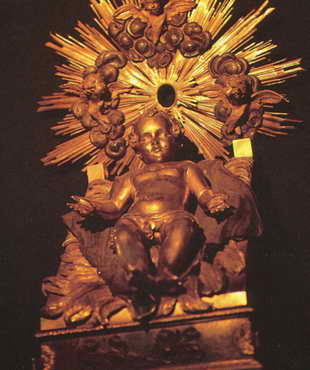 King Haakon I of Norway with the Christianization of Norway as well as rescheduling the date of Yule to coincide with Christian celebrations held at the time. The saga states that when Haakon arrived in Norway he was confirmed a Christian, but since the land was still altogether heathen and the people retained their pagan practices, Haakon hid his Christianity in order to receive the help of the "great chieftains." In time, Haakon had a law passed establishing that Yule celebrations were to take place at the same time as the Christians celebrated Christmas, "and at that time everyone was to have ale for the celebration with a measure of grain, or else pay fines, and had to keep the holiday while the ale lasted." | Here is a description of the Yule Practice: Wheel of the Year . . . | 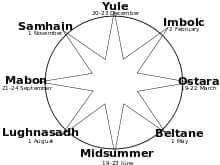 Yule was a heathen, pagan feast lasting twelve days, part of "Wheel of the Year". Yule is where we get the 12 Days of Christmas. It was ancient custom that when sacrifice was to be made, all farmers were to come to the heathen temple and bring along with them the food they needed while the feast lasted. At this feast all were to take part of the drinking of ale. Also all kinds of livestock were killed in connection with it, horses also; and all the blood from them was called hlaut [ sacrificial blood ], and hlautbolli, the vessel holding the blood; and hlautteinar, the sacrificial twigs [ aspergills ]. These were fashioned like sprinklers, and with them were to be smeared all over with blood the pedestals of the idols and also the walls of the temple within and without; and likewise the men present were to be sprinkled with blood. But the meat of the animals was to be boiled and served as food at the banquet. Fires were to be lighted in the middle of the temple floor, and kettles hung over them. The sacrificial beaker was to be borne around the fire, and he who made the feast and was chieftain, was to bless the beaker as well as all the sacrificial meat. The twelve months of the year were "condensed" or magically reflected during the twelve "holy nights when the Wild Hunt rides out". It is an especially dangerous time when evil spirits are abroad. Toasts were to be drunk. The first toast was to be drunk to Odin "for victory and power to the king", the second to the gods Njörðr and Freyr "for good harvests and for peace", and thirdly a beaker was to be drunk to the king himself. In addition, toasts were drunk to the memory of departed kinsfolk. These were called "minni [memorial toast]". | There is an element of anarchy and the reversal of social order about the Yuletide festivities, because the dying of the sun threatens a descent into primal chaos: it the end of the old cycle of existence, and order is restored only with its rebirth. The intervening period or ‘gap in time,’ the inter-calendar days of the twelve days of Yule, is especially magical and otherworldly, being a time on the verge of chaos when the barriers between the realms dissolve, when the veils between the living and dead are thin. Finnish shamans call it ‘The Dreaming’ or ‘God’s Trance Hour’. Several fairies are said to destroy any spinning left on the wheel at Yule or Christmas. This has its origin in the fact that many sun gods and goddesses were associated with spinning, either spinning the Cosmos itself, or sunbeams in the hours before dawn. At Yule, the midwinter solstice, when the sun stands still, all forms of spinning and weaving were forbidden because it was a pause in the turning of the wheel of the year. The Lapps forbade the turning of any kind of wheel, including cartwheels and churns. The pagan Romans also held the Saturnalia (worship of Saturn) festival at the winter solstice, and it is the origin of many Yuletide customs many peoples still practice today. Saturn (from satus meaning ‘sowing’), cognate with the Greek Kronos, is one of the elder Roman deities, "a god of time and agriculture". The feast commemorated the mythical age of Saturn's kingship, a Golden Age of happiness for all men. Like King Arthur, it is said that he lies asleep on a secret island and one day will return. In the meantime, once a year a temporary Golden Age was celebrated. Riotous merry-making took place, and lights were kept burning to ward off the spirits of darkness. Schools were closed, the army rested, and no criminals were executed. Friends visited one another with gifts: cakes, lamps, dolls, jewellery and incense. Temples were decorated with evergreens symbolizing life's continuity, and processions of people with masked or blackened faces danced through the streets. Masters served meals to their slaves who elected "a Mock King" to take charge of the revels. This custom continued with the Mediaeval "Lord of Misrule" in the Roman Catholic "church" who presided over the Christmas festivities. In England, the "Lord of Misrule" — known in Scotland as the "Abbot of Unreason" and in France as the "Prince des Sots" — was an officer appointed by lot at Christmas to preside over the "Feast of Fools". The "Lord of Misrule" was generally a peasant or "sub-deacon" appointed to be in charge of Christmas revelries, which often included drunkenness and wild partying, in the pagan tradition of Saturnalia. In most forms of Wicca, this holiday is celebrated at the winter solstice as the rebirth of the Great horned hunter god, who is viewed as the newborn solstice sun. The method of gathering for this sabbat varies by practitioner. Some have private ceremonies at home, while others do so with their covens. | The word Yule itself means "wheel," the wheel being a pagan symbol for the sun. Mistletoe was considered a sacred plant, and the custom of kissing under the mistletoe began as a fertility ritual. Hollyberries were thought to be a food of the gods. The tree is the one symbol that unites almost all the northern European winter solstices. Live evergreen trees were often brought into homes during the harsh winters as a reminder to inhabitants that soon their crops would grow again. Evergreen boughs were sometimes carried as totems of good luck and were often present at weddings, representing fertility. The Druids used the tree as a religious symbol, holding their sacred ceremonies while surrounding and worshipping huge trees. The earliest record of an evergreen being decorated in a church was in 1521 A.D. in a Roman Catholic "church," in the Alsace region of Germany. A prominent Lutheran minister of the day cried blasphemy: "Better that they should look to the true tree of life, Christ." In 350 A.D., "pope" Julius I declared that the Lord Jesus Christ's birth would be celebrated on December 25. There is little doubt that he was trying to make it as painless as possible for pagan Romans to convert to Christianity. This new religion to the pagans, Christianity (which was now being made another Gospel) went down a bit easier, knowing that their pagan feasts would not be taken away from them. Egyptians and Persians celebrated the birthday of their god on Dec. 25th. Other names applied to the sun god as a child are Mithras, Horus, Isvara, Deoius, Jupiter, Plutus, Ninus, Osiris, Dionysus, Bacchus, Iacchus, Adonis, Attis etc. All these myths of child worship originated from ancient Babylon with Semiramis and Nimrod. Serpent crosiers (staffs) were commonly carried by bishops and high Roman Catholic "church" officials in the Middle Ages. They claim that the crosier represents the shepherd’s crook, but it can be traced to the divining staff or augur of Pontifex Maximus of ancient Rome who inherited it from the priests of Babylon. | 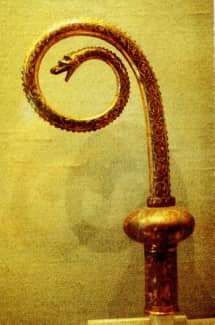 Adad, Enlil, Baal, Neptune, Poseidon and other “gods” of storm and sea were depicted as carrying tridents. It was symbolic of lightning. Here is
Neptune's, Trident | 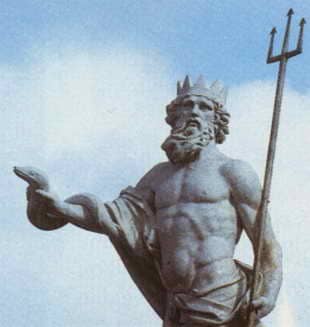 Baby Jesus, Trident | 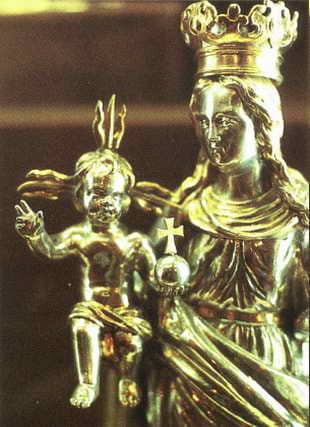 Cross with Trident | 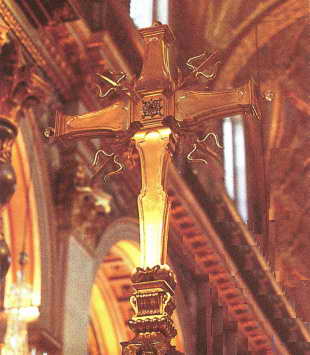 Pagan priests as half fish sprinkling holy water on Assyrian temple laver in the Pergamum Museum of Berlin. One of the names of this god in Babylon and Phylistia was Dagon (dag=fish, on=sun). The most common ways of depicting Dagon are described by the archaeologist Layard, “The Head of the fish formed the mitre above that of a man, while its scaly, fish-like tail fell as a cloak behind, leaving the human limbs and feet exposed.” Layard’s Babylon & Nineveh, p.343
| 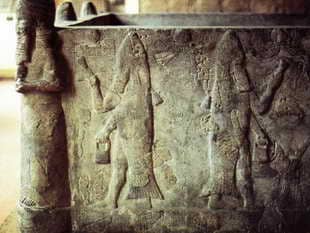 Dagon the sun-fish god, who was the father of Baal, again clearly displayed with fish attire and mitre. Note also the carvings and diagrams of Dagon priests and their fish head hats alongside the "pope" with his similar fish head hat holding the crooked cross of Mithra, or crosier. 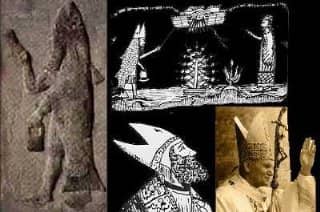 A crosier (crozier, pastoral staff, paterissa, pósokh) is the stylized staff of office (pastoral staff) carried by high-ranking Roman Catholic, Eastern Orthodox, Anglican, and some Lutheran and Pentecostal prelates. The other typical insignia of most of these prelates, but not all, are the mitre, pectoral cross, and the episcopal ring. The carving directly above shows the Dagon priests sprinkling holy water and is taken from the above image. A crosier (crozier, pastoral staff, paterissa, pósokh) is the stylized staff of office (pastoral staff) carried by high-ranking Catholic, Eastern Orthodox, Anglican, and some Lutheran and Pentecostal prelates. The other typical insignia of most of these prelates, but not all, are the mitre, pectoral cross, and the episcopal ring. Shown here is the western crosier of Archbishop Heinrich of Finstingen, 1260-1286.  One of the most visible evidences that sun god worship has continued under the name of Christianity is by looking at the Roman Catholic "pope". The so called "pope" openly displays the symbol of “Baal” (sun worship) at the forefront of his mitre, which symbolizes the Dagon god. The symbol of the Dagon is in the form of a hat or mitre.  Notice the open mouth of the fish at the top of the Pope’s mitre. The most famous temples of Dagon were at Gaza Judges 16:21-30, particulary verses 23 and 24, and at Ashdod 1 Samuel 5:3-7; 1Chronicles 10:10. Dagon was represented with the face and hands of a man and the lower half the body as the tail of a fish. Also, note on the staff the pine cone . . . 1 Samuel 5:3-4. Notice the open mouth of the fish at the top of the Pope’s mitre. The most famous temples of Dagon were at Gaza Judges 16:21-30, particulary verses 23 and 24, and at Ashdod 1 Samuel 5:3-7; 1Chronicles 10:10. Dagon was represented with the face and hands of a man and the lower half the body as the tail of a fish. Also, note on the staff the pine cone . . . 1 Samuel 5:3-4.This pine cone staff in the Egyptian Museum Turino, Italy is a symbol of the solar god Osiris and originated in Egypt where he was their messiah who died for his people and whose Mother, Isis, was worshipped as the Virgin Mother. Osiris was the Egyptian counterfeit of Jesus Christ. The pine cone on the tree of life, slowly ripens the conifer’s female seeds, and in the later stages the cone opens up to release its mature seeds. This process symbolizes the seeding effect on other people and culture together with the expansion of consciousness. 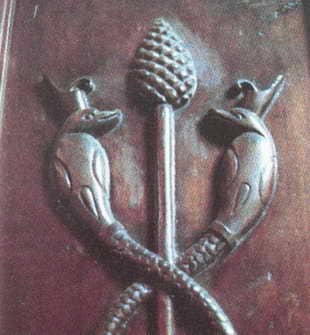 Below, the Assyrian winged god with pine cone, representing power of regeneration, traceable to Tammuz of Babylon. Most paganism in history is traceable back to Tammuz of Babylon. His mother Semiramis, was the first Virgin Mother predating the birth of the Lord Jesus Christ of Nazareth by over a 1000 years. The Roman Catholic "churches" practice of making "the Sign of the Cross" originated in Babylon as people paid homage to their messiah, Tammuz, who “died for the good of his people.” Their love for Tammuz was demonstrated by making the sign of the “T.” Satan has transferred this sign for Tammuz into the the Roman Catholic "church," as they think they are making the sign of the Christian cross. Tammuz was the Babylonian counterfeit of the Lord Jesus Christ of Nazareth.  See: Tammuz. See: Tammuz.The Greek god Dionysus carries the pine cone staff as a fertility symbol. Pine cones and pine cone staffs are very common on pagan statues and art symbols of fertility and regeneration. Children are always looked upon as extending the life of the human species. Therefore, it is predictable that the Pine Cone should be linked to the new life of the conception of children. Baal worshipers worshiped, or used as part of their worship: pine cones, peacocks, unicorns, and the phoenix..
|
 satanic images of the Vatican, 3.htm
satanic images of the Vatican, 3.htm
 Baal worship, Babylonian worship by the Roman Catholic 'church'.htm
Baal worship, Babylonian worship by the Roman Catholic 'church'.htm
 Back to Paul Harrell's Sermon Notes.
Back to Paul Harrell's Sermon Notes.
 Back to Paul Harrell's Second page.
Back to Paul Harrell's Second page.
 Back to Paul Harrell's Home Page.
Back to Paul Harrell's Home Page.

Alemattec_CS@hotmail.com
Copyright © 2012 Paul S. Harrell